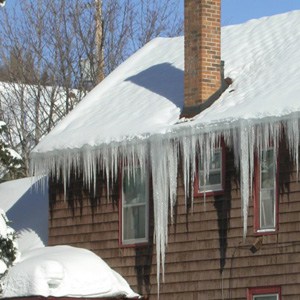Here in the Maryland/Pennsylvania area, we are in the height of the season for winter precipitation of all forms including snow, sleet, freezing rain, and ice. With the recent snow event that brought with it sleet and freezing rain on top of it all, you may want to check your roof to see if ice dams are forming. Ice dams can be bad news for your roof, your home, and potentially your health!
What is an Ice Dam?
An ice dam is a ridge of ice that forms at the edge of a roof and holds back melting snow from draining properly. As water backs up behind the dam, it can leak through the roof and cause damage to walls, ceilings, insulation and other areas. Ice dams can form when there is snow on the roof, warm (>32°F) sections of the upper roof, and cold portions of the lower roof (<32°F). As snow melts on the warmer areas, it will refreeze when it flows down to the colder portions near the gutters, forming an ice dam. Snow melting is often caused by heat loss from the building’s interior, but the sun’s radiation can also provide enough heat to melt snow at the roof covering even through several inches of snow! Contrary to popular belief, gutters themselves do not cause ice dams to form, although they certainly do help to concentrate ice build-up in dams.

Ice Dams Cause Problems!
Roofs are designed to quickly shed water, not hold water. Ice dams are problematic because they hold water on the roof surface for much longer periods of time than the roof is designed. This can force water to penetrate behind/under the roof covering materials and subsequently leak from the roof into the building envelope. Leaking areas of the roofing can potentially lead to:
- Rotting of roof decking, exterior and interior wall materials, and framing.
- Mold growth (which can in turn lead to respiratory illnesses (allergies, asthma, etc.) caused by mold).
- Reduced effectiveness of insulation. Wet insulation loses R-value quickly. Even if it dries, chronically wet insulation may not decompress. With diminished insulation effectiveness, more heat will escape from the home interior to the underside of the roof decking. This will cause more snow to melt, causing more ice dams, which will likely lead to more leaking.
- Peeling paint. Water from the leak can infiltrate wall cavities and can cause paint (on both interior and exterior finishes) to peel and blister. This may happen long after the ice dam has melted. It may not appear directly related to the ice dam to the average homeowner after the ice dams are long forgotten.
Preventing Ice Dams
The overall goal for preventing ice dams is to keep the entire roof cold. Here are some suggested ways to help keep roof surfaces cold:
- Increase the thickness of insulation on the attic floor, ductwork, and chimneys that pass through the attic.
- Seal air leaks in the attic floor including areas surrounding wire and plumbing penetrations, attic hatches, and ceiling light fixtures penetrating the attic floor from the living space below.
- Consider installing a metal roof. The design of the metal roof will not allow the melting water to penetrate through the roof’s covering materials and snow/ice can more easily slide off the smooth surfaces of the metal.
- Maintain a minimum of 3″ air space between the top of insulation and the roof sheathing in sloped ceilings to promote airflow/ventilation.
- Remove snow (carefully) from the roof. You could try using a roof rake from the ground, being careful not to damage roofing materials or dislodging dangerous icicles. Do NOT
use shovels, hammers, ice picks, rakes, or whatever other destructive items you find in the shed/garage/workshop! Despite the temptation, do NOT get on the roof or use a ladder when trying to remove snow! Safety should always be your top concern. - Avoid using heat cables. They are problematic, not energy-efficient, and can shorten the life of roofing materials such as asphalt by making them become brittle. They may also void your roof materials warranty in some cases.
In summary, ice dams are caused by the melting and re-freezing of snow that is caused by temperature differentials in the roofing surface. These temperature differentials can be caused by energy loss from the inside of the home into the attic space, often due to inadequate insulation in the attic space and/or between the ceilings and roof decking and/or poor attic ventilation. Ice dams can be very destructive to your home, and if you have ice dams, you should take action to prevent them from forming before they cause thousands of dollars of damage to your investment!
Portions of this article are not the author’s original work and were sourced under copyright permission from the International Association of Certified Home Inspectors (InterNACHI).
